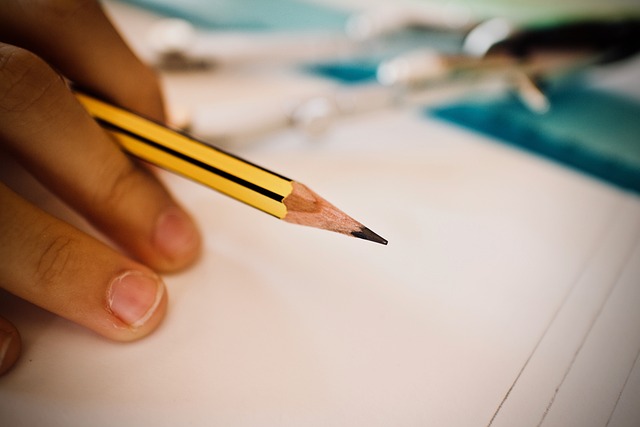Common Classroom Problem #1
Every teacher’s nemesis.
Yes, you guessed it. They have no pencil which makes them unprepared for class work.
So, what are some solutions to this everyday common classroom problem?
Typical Scenario
“OK class. Now that you know what your assignment is, you can get started,” this is you (or me) giving the final go-ahead after having gone over the topic and what you want your students to do.
You (or I) begin walking around the room making sure your charge is on task. You spot Johnny (or Susie or whomever) just sitting there or goofing around or looking out the window. “Johnny,” you get his attention, “why aren’t you working?” He looks at you with a smug expression and replies, “I don’t have a pencil.” Like that is a legitimate excuse. Hah. Grrr.
“Does anyone have a pencil Johnny can use?” you ask the class. Sometimes that works, sometimes not. Or, you move to your desk and fish around for one. More time lost. Possible class disruption. etc etc
I stopped trying to figure out why some students don’t bring a pencil (or pen or whatever) and just chalked it up to “not caring” and/or “low priority” on their totem pole of reasons for being in school.
Solution?
I asked AI for 10 remedies to this issue (see #1-10 below).
Naturally, I am going to go through and comment on each one to see if AI came up with a good one or to “shoot down” its logic. You know, find the pros and cons by drawing on my years of experience. Or, as I’m outlining it – the Good, the Bad, and the Ugly.
Middle Ground? Sure. There’s room for compromise.
AI’s solution is set in italics. My response is in normal text.
At the end, I’ll offer some of my own solutions and experiences.
Be mindful that my experience is largely in the middle school classroom. That is where my insights to address this common classroom problem originate.
AI’s top 10 solutions to this common classroom problem
With that said, here goes:
Pencil Station Setup
Establish dedicated pencil stations at various locations in the classroom, making it easy for middle schoolers to grab a pencil if they forget to bring one.
I would suggest one station, two tops. And, place those stations in areas where they don’t disrupt instruction.
Put one or two students in charge of collecting pencils and returning them to the station. Yes, reward those helpers because you know few will work for nothing. There are some students who have kind hearts, but most won’t do it without a reward.
The Good – They know where to grab a pencil when needed. You don’t have to worry about these details.
The Bad – If pencils aren’t returned, which will happen, that is a problem.
The Ugly – Pencils get left on desks, floor, window sill, etc. Unreturned pencils deplete your stockpile which circles around to bite you someday.
Clear Pencil Policy
Develop a straightforward policy specifically addressing the importance of bringing pencils to class in middle school. Consistently enforce consequences for not having one.
This sounds great on paper, but, without proper and continued enforcement breaks down very quickly. Having this as part of your start-of-the-year syllabus is a good idea.
The Good – They know where you stand on pencils and being prepared. You can always refer back to your classroom practices/policies. [science classroom organization-another 4 part series]
The Bad – As mentioned above, without consistency in enforcing it, it degrades quickly and becomes a joke.
The Ugly – There could be parental fallout. It’s true. Some parents will feel you should provide for their child. But, you know it’s not your duty. You’re trying your best to build responsibility (amongst other good character traits).
Borrow-a-Pencil System
Implement a system where students can borrow a pencil for the duration of the class, emphasizing the importance of returning it at the end to encourage responsibility.
This became my go-to method.
Don’t have a pencil? Borrow one from someone.
You want to borrow one from me? It comes at a price. see below
The Good – Borrowing falls on them asking from peers. The prepared students who lend are VERY picky about getting their writing implements back. For me, yes, I keep some on hand. BUT,…
The Bad – If borrowers don’t return pencils to their peers, it could create class disruptions.
The Ugly – Spinning off of “the bad”, could lead to escalating unwanted behaviors. In extreme cases, I have encountered pushing, harsh words… from lenders who did not get their pencil back.
Pencil Check-In Routine
Start each class with a quick pencil check-in, ensuring middle schoolers have their pencils ready before beginning any activities.
I don’t care for this one as it’s not my job to police them every class period to make sure they came prepared. In sum, there is enough of a load on the teacher’s “plate” without having to go through this continually.
If you wanted to start the process at the beginning of the year and stop after so many weeks, I could see that.
Let’s leave out the Good, the Bad, and the Ugly on this one. Didn’t the comments above do that?
Rotating Responsibility Chart
Create a chart where students take turns being responsible for bringing pencils to class on different days of the week, fostering a sense of accountability among peers.
I’m not a fan of this one at all.
Why doesn’t this idea really address this common classroom problem? Well, they’re middle schoolers. This sounds to me more like an elementary school idea…and I still wouldn’t like it there either.
The Good – With responsible students, this could work. It would also take that responsibility off your plate (mostly). Each student bringing start-of-the-year pencils could possibly make this work for some of the year.
The Bad – If someone doesn’t buy in, it creates a kink in the system.
The Ugly – If I read this right AI, you’re suggesting students bring pencils for the whole class. Hmm, again, middle schoolers… I don’t think so. With a start-of-the-year supply on hand, you have something to work with.
Incentives for Preparedness
Offer middle schoolers incentives like extra credit points, classroom rewards, or small prizes for consistently bringing pencils to class.
This one has some merit and I kinda like the idea.
The Good – There aren’t many students who aren’t up for a reward or incentive.
The Bad – If the rewards aren’t appealing to most, this can be a downfall.
The Ugly – There are some students that won’t be incentivized by your typical rewards. Candy? Maybe. Extra credit? That’s for the hard workers or those who, at the last minute, realize they need a few points to pass or increase their grade.
Parent Communication
Maintain open communication with parents or guardians regarding their child’s forgetfulness with pencils, seeking their support in addressing the issue at home.
This is an important method for dealing with thisl common classroom problem in my experience for those lingering or persistent cases.
The Good – Most parents are concerned and supportive. Especially when you catch them at parent conferences.
The Bad – Not being able to reach parents is a negative. Also, having to take time out of your day, evening, or planning is also a minus.
The Ugly – There are some parents who don’t want to be bothered. Let’s just call them the ones who see school as a “babysitting service”. They could be the ones who create blowback from your calls. Would they be the parents who are receiving call after call after call from all Little Johnny’s teachers?
Peer Support System
Encourage middle school students to support each other by implementing a peer accountability system, where classmates remind each other to bring pencils and help each other stay organized.
I don’t see this one answering this common classroom problem in many scenarios. Maybe I’m wrong and you have the kind of student body that would thrill at this. Or, possibly, your counselors would take on that responsibility.
The Good – Students are holding each other accountable. You aren’t part of the process. Well, at least not for most of it. Friends would work well within their own groups. I can see that. And, there are others with compassionate hearts that would be willing and able to help.
The Bad – Without buy-in, this falls by the wayside quickly.
The Ugly – Well? What are your thoughts?
Personal Pencil Pouches
Provide each student with a pencil pouch to keep their pencils organized and easily accessible throughout the school day.
I’m jumping straight to the Good, Bad, and Ugly on this one.
The Good – Great idea. Keeping the pencil pouch in your room, just for your class, makes the idea even better.
The Bad – To begin, you would have to use your class funds for this. Maybe it’s enough of a problem that this is a great solution. Or, maybe, your student supply list stipulates pencil pouches for each child and 3-to 4 dozen pencils. You have to provide a location to store these items.
The Ugly – I can see students taking the pencil pouch with them to other classes and leaving it there, at home, on the bus, bathroom… Once it leaves your room, it is almost certainly GONE.
Organization Skills Lessons
Dedicate time during advisory or study hall to teach middle schoolers essential organization skills, including packing their bags the night before, keeping track of materials, and maintaining a designated spot for pencils in their backpacks.
Does your school do this? It’s a great idea to deal with this common classroom problem. I’ve never seen it in a school-wide application.
The Good – As above, Great idea. These are key skills all middle schoolers need to learn and maintain. Using times other than your class is perfect.
The Bad – All teachers have to abide by this. Some schools don’t have this and it is up to the teachers to teach it.
The Ugly – Regardless of how successful the program is implemented and presented, it falls back on students to keep it going. Again, we’re dealing with middle school students.
What has worked for me
Looking over my experiences, I opted for the following measures in dealing with this particular common classroom problem:
- Ask your neighbor if you can borrow a pencil, pen…
- “I’ll trade you a pencil for” one shoe, your cellphone, “something of value” you will desire to get back.
- Golf pencils with no erasers (bought with school supply money)
- Pencils were collected at the end of the day from my floor and the sweepings of the custodians as they cleaned room to room. Yes, I grabbed them regardless of the hair around them, how well chewed or broken (but usable)… they were. Each is lovingly placed in my whiteboard marker tray for the taking. And, yes, I thoroughly washed my hands afterward.
- “I’ll sell you one,” said me. “How much?” they ask. Used cost less than brand-new ones.
Wrap Up for this Common Classroom Problem
Dealing with the all too common classroom problem of missing pencils is every teacher’s plague. It’s a scenario we’ve all encountered: helplessness little Johnny or Susie without a writing tool in hand, testing our patience with their unconcern.
Fear not, for AI offers a slew of solutions. Or, does it? The answers range from pencil stations for forgetful souls to creating clear policies on preparedness.
However, educators like myself find solace in more practical approaches, from encouraging peer borrowing with a twist of accountability to creatively sourcing pencils from hidden treasure troves.
The solution is a concoction of incentives, enforcement, and a smidge of resourcefulness to sail the seas of the missing pencil.
Reflecting on years of trial and error, my own arsenal of strategies ranges from the barter “I’ll trade you a pencil for…” negotiations to the practical salvage operations from custodial rounds. And yes, I’ve even peddled a few, offering a somewhat budget-friendly solution to classroom consumers.
In the end, the solution comes down to the ingenuity and adaptability of you in tackling the everyday challenges of this common classroom problem, one pencil at a time.
What are your thoughts?
Advice, Ideas of others







